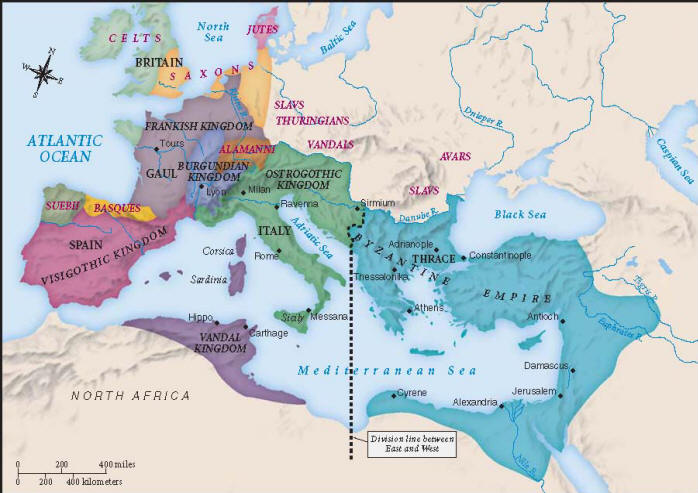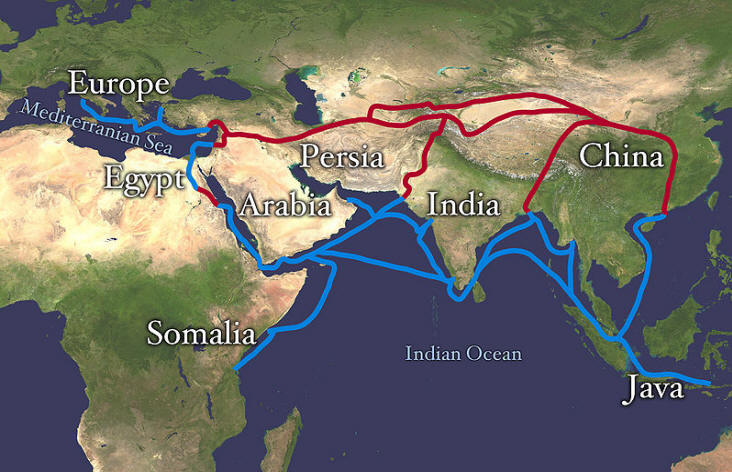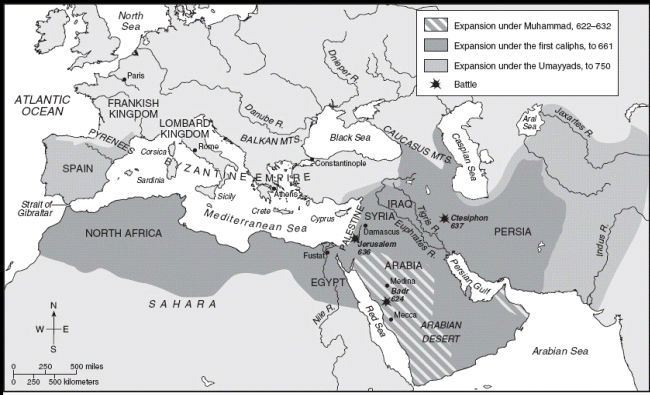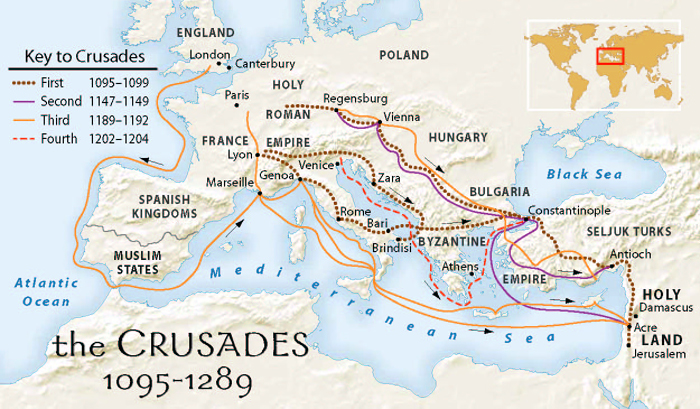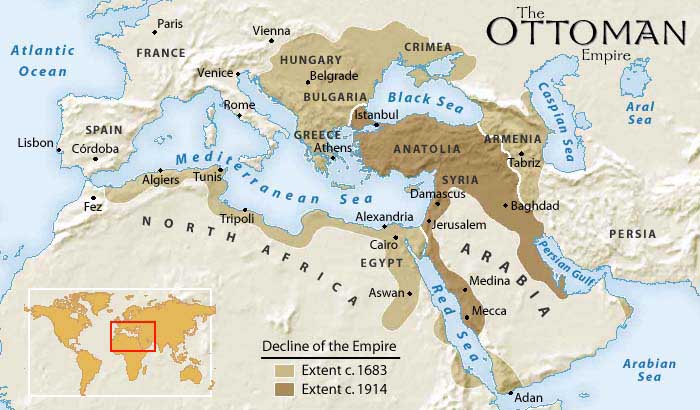Maps 3: History - Middle Period
HUM 213 Historical Overview
URL of this web page:
http://web.cocc.edu/cagatucci/classes/hum213/Maps/Maps3HistoryMiddle.htm
|
Map 1.9 "Peoples and Kingdoms of the Roman World, 526 [C.E.]"
[Map Caption:] "The provinces of the Roman Empire had always been home to a population diverse in language and ethnicity. By the early sixth century [C.E.], the territory of the western empire had become a mixture of diverse political units as well. Italy and most of the former western provinces were ruled by kingdoms organized by different non-Roman peoples, who had moved into former imperial territory over several centuries. The eastern empire remained under the political control of the emperor in Constantinople" ("Peoples and Kingdoms of the Roman World, 526 [C.E.]" [Map.]). |
|
Works Cited
"The Spread of Christianity,
300-600 [C.E]."
[Map.] "MapCentral: Christianity."
Bedford-St. Martin's Make History. Web. 29 Jan. 2011.
<http://bcs.bedfordstmartins.com/makehistory2e/MH/Home.aspx>.
"Peoples and Kingdoms of the
Roman World, 526 [C.E.]." [Map.] "MapCentral: Roman
Empire."
Bedford-St. Martin's Make History. Web. 29 Jan. 2011.
<http://bcs.bedfordstmartins.com/makehistory2e/MH/Home.aspx>.
|
The Silk Routes, ca. 200 BCE - 1400 CE
|
Map 1.10 The Silk Roads ("File:Silk Route.jpg" [Map]) |
|
|
"The Silk Roads" Map Description: Land routes (indicated by red lines) and water routes (indicated by blue lines) retrace the "extensive interconnected network of trade routes . . . connecting East, South, and Western Asia with the Mediterranean world, as well as North and Northeast Africa and Europe" ("Silk Road"). These major overland and maritime trade routes are collectively known as the "Silk Road," named for "the lucrative Chinese silk trade, which began during the Han Dynasty (206 BCE - 220 CE)" in China, and became "a major reason for the connection of trade routes into an extensive trans-continental network" covering some 4,000 miles ("Silk Road"). For some 3,000 years, the "Silk Routes . . . were important paths for cultural, commercial and technological exchange . . .," and "silk was by no means the only item traded" ("Silk Road"). Slaves were traded and non-indigenous diseases were spread Also traveling the Silk Roads were cultures and religions, knowledge and ideas. better, as well as slave er;; sd slaves trades and non-indigenous diseases and slave trades, and much more. |
|
Works Cited "File:Silk route.jpg" [Map]. 27 May 2010.Wikipedia: The Free Encyclopedia. Wikipedia Foundation, 2011. Web. 30 Jan. 2011. <http://en.wikipedia.org/wiki/File:Silk_route.jpg>. "Silk Road." 29 Jan. 2011. Wikipedia: The Free Encyclopedia. Wikipedia Foundation, 2011. Web. 30 Jan. 2011. <http://en.wikipedia.org/wiki/Silk_Road>.
|
MIddle Period Arabia and Persia: The World of Islam
|
Arabia and Persia: The
World of Islam |
||
|
Overview of Middle Period Arabia and Persia "In the seventh century, the Arab Empire rapidly expanded its territory well beyond the Arabian Peninsula, following in the Bedouin tradition of conducting tribal razzias (raids). By 640, it had conquered the Persian Empire and Egypt, and although the empire would disintegrate by the thirteenth century, the highly developed civilization created by the Muslims would outlive the empire that gave birth to it. In the two centuries following Mohammed's death, Islamic civilization would reach its peak under the first two dynasties, beginning with the Umayyads (661-750), in Damascus, who greatly expanded and unified their territory from Africa to Asia. Under the Abbasids (750-1258), the new capital of Baghdad became a world-renowned center of trade and cultural exchange where trade wealth provided generous patronage for art and scholarship. Harun al-Rashid (786-800) would rule so lavishly that Baghdad under his reign became the model for the Ottoman and Mamluk sultanates depicted in One Thousand and One Nights. Throughout the vast empire, a number of thriving cities (among them Cordoba, Granada, Basra, and Marrakesh) became vital centers for trade and cultural exchange. With the advent of paper manufacture in Baghdad, historians such as al-Mas'udi (896-956) began to record Arab history in writing for the first time. The years between 900 and 1200 represented the peak of Muslim civilization, with its territory stretching from the Atlantic to the Indian Ocean. Although the Arabic language and belief in Islam (adopted by many conquered kingdoms) unified the empire, as early as 1000 it was already becoming decentralized into various caliphates and dynasties. This period was considered the Golden Age of Islam but it was also a time of great upheaval, with Mongol attacks on the Persian Empire led by Chingis Khan (1162-1227), beginning about 1230; the threat of bubonic plague; and the incursions of Crusaders in the Mediterranean. As the empire expanded and the influence of other civilizations enriched Islamic culture, travel over the Silk Road and other trade routes was common for traders, merchants, and Muslims on spiritual pilgrimage. The twelfth and thirteenth centuries also saw the rise of Sufism and other mystical traditions, such as Bhakti in India. In addition to the Persian and Turkish influences it had absorbed earlier, late Middle Period Arabic culture (especially art) was newly influenced by the Mongols and the Chinese. As the Abassids gradually lost control of their far-flung territories in Africa and elsewhere, the Seljuk Turks seized Baghdad in 1055. The empire began to disintegrate further as Chingis Khan conquered Central Asia and the Middle East, and the Abassid caliphate ended at last in 1258 as the Mongols captured Baghdad in a bloody battle. The Mongols continued to capture territory as far as the Red Sea but were resisted by the Mamluks (former Turkish slaves who had converted to Islam) in Egypt. By the mid-fourteenth century, the Mongol Empire too had begun to break apart and Cairo became the new center of Islamic civilization under the Mamluks." |
||
|
http://bcs.bedfordstmartins.com/makehistory2e/MH/ImagePreview.aspx?BfwUid=c0a84df9:10cc53e1256d504fb2-7ac3
Islamic Empire Maps
|
[image: . . .islam_750.jpg |
|
|
|
Source of above map: http://www.islamproject.org/education/islam_750.html Menus: http://www.islamproject.org/education/Maps-pickem.htm
The Islam Project:
Maps "Islam, c. 750" |
http://bcs.bedfordstmartins.com/makehistory2e/MH/ImagePreview.aspx?BfwUid=c0a84df9:10cc53e1256d504fb2-7ade
Crusades Maps
http://bcs.bedfordstmartins.com/makehistory2e/MH/ImagePreview.aspx?BfwUid=c0a84df9:10cc53e1256d504fb2-7aa9
Image: map10_4_Crusades
|
[image: . . .islam_750.jpg |
|
|
|
Source of above map: Menus: http://www.islamproject.org/education/Maps-pickem.htm
The Islam Project . . .
|
http://bcs.bedfordstmartins.com/makehistory2e/MH/ImagePreview.aspx?BfwUid=c0a84df9:10cc53e1256d504fb2-7aa2
Ottoman Empire Maps
|
[image: Ottoman_Empire_b.jpg |
|
|
|
Source of above map: http://www.islamproject.org/education/Ottoman_Empire.html Menus: http://www.islamproject.org/education/Maps-pickem.htm http://www.islamproject.org/education/Maps.htm Image Reference: Ottoman_Empire_b.jpg
The Ottoman Empire:
1350 to 1918 |
TO BE CONTINUED . . . .
http://bcs.bedfordstmartins.com/makehistory2e/MH/ImagePreview.aspx?BfwUid=c0a84df9:10cc53e1256d504fb2-7b19
http://bcs.bedfordstmartins.com/makehistory2e/MH/ImagePreview.aspx?BfwUid=c0a84df9:10cc53e1256d504fb2-7a73
Image: map21_3_EuropeAfterWWI
Major Nazi Concentration Campus in World War II
http://bcs.bedfordstmartins.com/makehistory2e/MH/ImagePreview.aspx?BfwUid=c0a84df9:10cc53e1256d504fb2-7a50
NaziConcentrationCampsM11_1
http://bcs.bedfordstmartins.com/makehistory2e/MH/ImagePreview.aspx?BfwUid=c0a84df9:10cc53e1256d504fb2-7a63
